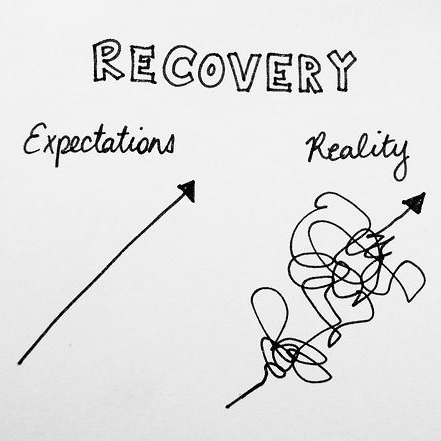Via Educate4Change
Think about your disposition right now. What are you feeling? How do you feel in relation to others, to your centre, to your aspirational self? What preoccupations come up as barriers to balance or comfort?
The great thing about therapy is that you get to chart your progress from where you started. This can mean measurable changes through record-keeping or coping strategies, or intangible changes like confidence in emotionally vulnerable situations. And keeping tabs on your progress is a helpful way to celebrate milestones of all kinds.
What can be challenging in charting your mental health journey is that it suggests that healing, growth, and progress are all linear. They’re really, really not. Lots of dated but still prevalent understandings of mental health only address moving from Point A to Point B in a straight line. Those perspectives assume that once someone’s on the path to emotional wellness that anything other than positive, upward momentum is scary or constitutes a failure.
Let’s debunk that right now. Healing never (never!) happens in a straight line.
There will always be moments, days, or weeks, that feel like your progress has stalled out or that you’re sliding backward. This is normal. Our brains need time to adjust to new patterns. With any change comes new situations that force the brain to adapt using its new neural pathways or with the support of its new supportive medication. Those pathways are still being built, so they’re not as well-traveled as the other ones. It’s easy for brains revert back to what’s comfortable, which can lead to feelings of frustration or shame around not responding “the right way” or “the new way”.
Your brain is learning something new! It’s kind of like learning choreography: you might get the moves mixed up, but you get better the more times you do it. Every moment of practice makes those paths a little clearer. As you’re learning, you might nail one bit and still be working on another. Just because you make a mistake in the part you thought you’d perfected doesn’t mean it’ll stay like that forever.
The frustrating part for a lot of folks is the feeling of powerlessness that comes with the healing process. Once you have the coping mechanism or the language to identify something, it’s easy to want the change to come all at once. A common refrain is, “Why can’t I just [do the thing] now that I know how?”
Try to release the pressure to be perfect. The re-trying is where the strongest connections happen. That is, the pathfinding and the habit-forming. These connections become strengthened when they have to work a little bit, so those moments of imperfection in deploying new thought patterns give the brain more power to recognize what to do in future situations.
While having high expectations is often associated with good results (or at least an elevated work ethic), that’s actually a false assumption. High expectations can make the ideal outcome seem further away than it is, since it drains the journey of its learning moments. Every perceived failure isn’t only that, it’s an opportunity to do a different iteration of the thing. It’s the difference between the second rehearsal and the show: time, practice, and support.
So be gentle with the healing process. Allow for imperfection in healing, because it supports your ability to be adaptable and strengthens the connections you’re working on. There’s so much good in being fallible. In fact, it’s the part that strengthens the change the most.
How does this work?
If I had to wager a guess, you’re here to figure out whether I am a good fit to be your therapist. The fastest way to do that is to schedule a free consultation, and go from there!

